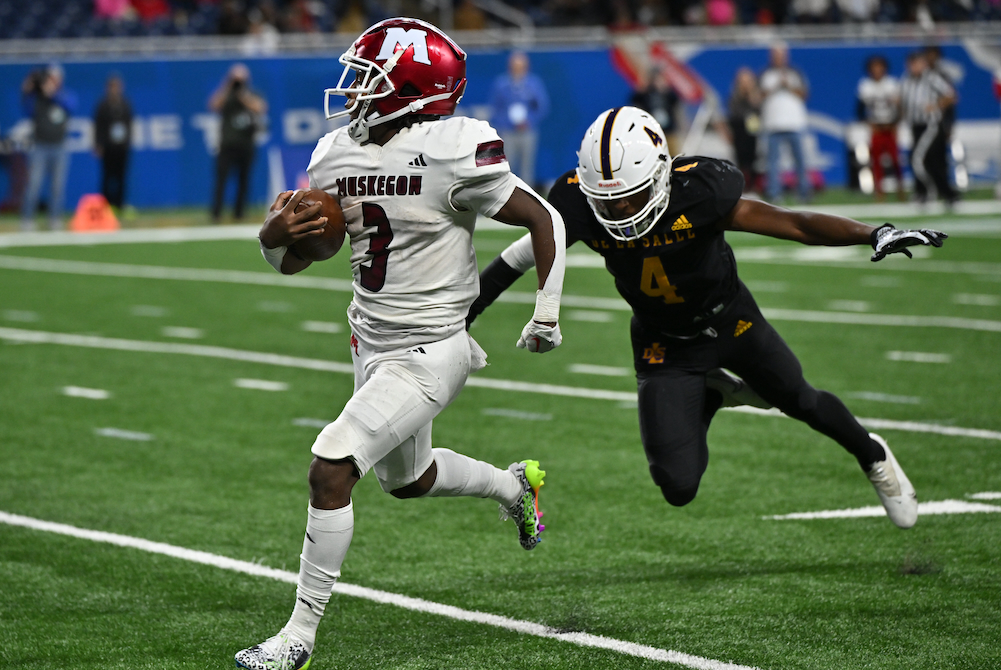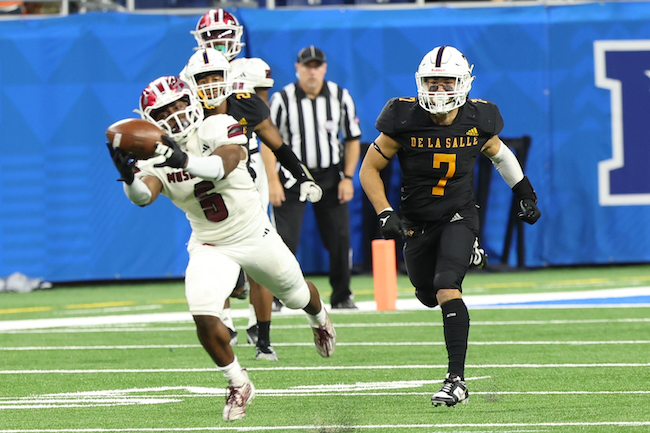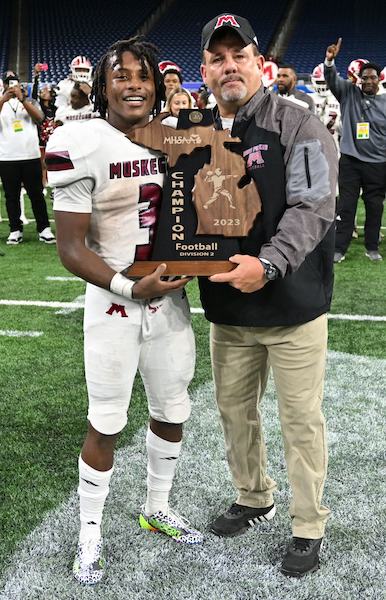
Haslett Saving Big Hits for Game Time
August 16, 2016
By Geoff Kimmerly
Second Half editor
HASLETT – The sound of cleats on pavement. He and his teammates, hand in hand, walking toward the field together minutes before kickoff. Manowar’s “Heart of Steel” ringing in their ears from a few minutes before.
 Justin Kuchnicki gave himself goose bumps Monday describing Haslett’s weekly pregame ritual, which the senior lineman will take part in again beginning Aug. 26 when the Vikings open this season against Remus Chippewa Hills.
Justin Kuchnicki gave himself goose bumps Monday describing Haslett’s weekly pregame ritual, which the senior lineman will take part in again beginning Aug. 26 when the Vikings open this season against Remus Chippewa Hills.
They’ll certainly be revved up – and especially to lay some big hits after saving them up during three weeks of non-collision practices.
Haslett has one of the most successful football programs in the Lansing area, with two trips to MHSAA championship games and 14 playoff appearances total over the last 18 seasons. The Vikings finished 6-4 a year ago against a schedule featuring four eventual playoff teams.
The program also might be the first in all of Michigan high school football to fully eliminate full-speed hitting at practice, something Haslett has moved toward over the last few seasons before longtime coach Charlie Otlewski decided to knock it out of his practice plans completely this fall in large part to keep his players healthier for when it matters most.
“It gives you the edge when it gets to game day. You practice all week and you’re not really hitting or doing anything like that, and you get to game day … and everyone’s ready to just go out there and fly around and make plays,” Kuchnicki said. “You’re not really worried about kinks and stuff in your body that you’d have from practices, so you just go out there and lay it on the line.”
Friday was the first day Michigan high school players were allowed to practice in full pads. Storms drenched mid-Michigan that afternoon, so Haslett’s first day in full gear was Monday. And from a distance, it sounded like any other full-contact practice with the normal hoots and hollers and smacking of pads.
But on closer look, it was anything but. Lineman worked against blocking dummies on a sled or teammates holding hand pads. When the offense came together to run plays, linemen blocked against overturned plastic trash barrels. On the opposite end of the field, subvarsity players worked on defensive pursuit angles but again without hitting. Under a set of uprights laid an old gymnastics mat used to soften the fall during tackling drills, which players again did against standup dummies instead of their teammates.
Reducing collisions – that is, live, game-speed, player-vs.-player hitting – remains the focus of most conversations on health and safety in football. Much of the discussion is centered on reducing concussions, and MHSAA rules changes that took effect beginning with the 2014 season limit teams to one practice per day during the preseason (when teams frequently practice twice) where collisions can take place. During the regular season, teams can have collisions during practice only two days per week.
 Otlewski – who formerly coached St. Ignace from 1990-93 before taking over at Haslett in 1994 – said his practices used to follow what could be considered a traditional after-school plan: individual position drills for an hour or more followed by 11-on-11 full contact team practice for 30-40 minutes, twice a week.
Otlewski – who formerly coached St. Ignace from 1990-93 before taking over at Haslett in 1994 – said his practices used to follow what could be considered a traditional after-school plan: individual position drills for an hour or more followed by 11-on-11 full contact team practice for 30-40 minutes, twice a week.
But a handful of reasons, chiefly the desire to avoid injuries, started his program on a different path five years ago.
“Nobody wants injuries, but you surely don’t want them in practice. Then the concussion thing started to happen. (But) we didn’t do it because of concussions; we did it because of general overall injuries,” Otlewski said.
“If we lose a guy in Thursday’s scrimmage, or next Thursday in a game, OK, that’s football. But what we don’t want to do is lose someone in practice, because that seems unnecessary.”
The initial changes Haslett began to make to practices that fall of 2011 became drastic two years later, when he and his staff went to a different practice model completely. The Vikings now break every practice into 10-minute sessions alternating between team time and position drills, so position coaches can work with players individually before and after seeing how they perform when all 11 are running plays together.
This new breakdown brought the amount of player-on-player contact at practice down significantly as much more time was dedicated to learning proper footwork, blocking and tackling techniques and other fundamentals. Players on Monday worked at 50-percent speed, at most, against teammates either in front of them and also not moving at game speed, or against others holding pads and dummies.
The last two seasons, the only full-contact session during practices came during preparation for goalline situations; Otlewski and his staff decided to eliminate those this fall as well.
“We’re OK with a certain level (of contact). But we never want to go on the ground; we always want to stay up,” he said. “We want to go fast enough so where we have to use the perfect technique to get there footwork-wise. But we’re trying to eliminate the physicality part.”
To be clear, eliminating all collisions/contact is not required by the MHSAA. And there are probably more than a few in the coaching fraternity who would think Haslett is making a massive mistake.
But the Vikings’ no-contact strategy follows a way of thinking made popular in part by coaches like Dartmouth College’s Buddy Teevens, whose team hasn’t tackled during practices in six years. The Ivy League as a whole adopted a policy of no tackling in practice for the regular season beginning this fall.
 Otlewski said teaching to tackle without contact allows his players to practice the same technique-building drills during four-player offseason workouts, his team’s no-pads summer camp and then while wearing pads during the season. His defense doesn’t face a live offense during the week, but he doesn’t think his players lose out because they can gain just as much from watching film and working on pursuit angles and recognizing formations. Same goes for his offense, which can still practice skill work and the passing game full-speed while lineman go half-speed working on footwork and blocking technique.
Otlewski said teaching to tackle without contact allows his players to practice the same technique-building drills during four-player offseason workouts, his team’s no-pads summer camp and then while wearing pads during the season. His defense doesn’t face a live offense during the week, but he doesn’t think his players lose out because they can gain just as much from watching film and working on pursuit angles and recognizing formations. Same goes for his offense, which can still practice skill work and the passing game full-speed while lineman go half-speed working on footwork and blocking technique.
And he sees 37 players on his varsity roster, with that total remaining consistent over the last many seasons – while three opponents on this year’s schedule don’t have junior varsities and a fourth won’t field a freshman team.
His players three seasons ago didn’t really like the idea of not hitting in practice at first. But they’ve since bought in. He hasn’t heard a ton from parents either way; but he taught a class on football for local moms over the winter, and they seemed to like the idea as well.
“On one hand, I’m a little apprehensive,” Otlewski said. “OK, we haven’t gone full go. Is there a difference all of a sudden when it’s live Thursday against (Grand Rapids) Christian? Are we going to be up to speed?
“I think I still worry about that a little bit. But once we get into it, it’s fine.”
Kuchnicki is just as confident. Contact doesn’t bother this guy. He’s 6-foot-6 and in the neighborhood of 320 pounds. Sure, he’d love to have one contact practice this year so he and his teammates can back up some of the trash-talking they do to each other on the field.
But he’s fine with saving his biggest hits for opponents – and especially those who might think Haslett won’t be prepared for a physical game.
“They’d probably think we’re soft,” Kuchnicki said. “But when it comes game day, they change their minds instantly. I’ll tell you that.”
 Geoff Kimmerly joined the MHSAA as its Media & Content Coordinator in Sept. 2011 after 12 years as Prep Sports Editor of the Lansing State Journal. He has served as Editor of Second Half since its creation in Jan. 2012. Contact him at [email protected] with story ideas for the Barry, Eaton, Ingham, Livingston, Ionia, Clinton, Shiawassee, Gratiot, Isabella, Clare and Montcalm counties.
Geoff Kimmerly joined the MHSAA as its Media & Content Coordinator in Sept. 2011 after 12 years as Prep Sports Editor of the Lansing State Journal. He has served as Editor of Second Half since its creation in Jan. 2012. Contact him at [email protected] with story ideas for the Barry, Eaton, Ingham, Livingston, Ionia, Clinton, Shiawassee, Gratiot, Isabella, Clare and Montcalm counties.
PHOTOS: (Top) Haslett lineman work on blocking during Monday's practice. (Middle) Vikings coach Charlie Otlewski instructs his players on one of the team's blocking schemes. (Below) Backs work on the option with barrels serving as the defensive front.

Guy Delivers Champion's Trophy This Time After Sparking Muskegon's Comeback Win
By
Paul Costanzo
Special for MHSAA.com
November 26, 2023
DETROIT – M’Khi Guy was going to get his hands on the championship trophy no matter what happened in Saturday night’s Division 2 Football Final.
Handing out the championship and runner-up trophies is one of the perks of being part of the MHSAA Student Advisory Council, of which the Muskegon senior is a member. As much of an honor it would have been either way, Guy wanted to do everything he could to make sure he was handing the bigger wooden mitten to his coach, Shane Fairfield.
After rushing for 215 yards, throwing for 159 and accounting for four touchdowns, Guy got to do just that, placing the Division 2 championship trophy into Fairfield’s hands following Muskegon’s 33-21 victory over Warren De La Salle Collegiate at Ford Field.
“It’s awesome,” Guy said. “Last year wasn’t too fun for me, because I had to give it to the opposing team, Detroit (Martin Luther) King. But this time, I got to give it to my coach, my guy right here, and it made me feel great.”
Muskegon prevented De La Salle from winning a third straight Division 2 title while claiming its seventh Finals championship. It was the first since winning it all in 2017, and in between then and now Muskegon had finished runner-up three times, including a year ago to King.
 “Everyone was wanting us to give up and quit and not get here,” Fairfield said. “‘You’re going to lose when you get there.’ And, like I said before we left, people want us to fall apart, people want us to break. I said we will not be broken today. We keep telling these guys to follow us and trust us. As much as they get the naysay, for these young men to believe in this coaching staff and their school district, in each other – words do not describe it.”
“Everyone was wanting us to give up and quit and not get here,” Fairfield said. “‘You’re going to lose when you get there.’ And, like I said before we left, people want us to fall apart, people want us to break. I said we will not be broken today. We keep telling these guys to follow us and trust us. As much as they get the naysay, for these young men to believe in this coaching staff and their school district, in each other – words do not describe it.”
Muskegon (13-2) had to muster up some extra belief at halftime as it was down 21-7, and outside of an 80-yard touchdown run by Guy had gotten next to nothing going on offense.
That changed almost immediately in the second half, as Guy ran for a 52-yard score on the first possession of the half, and Muskegon wound up out-scoring the Pilots 26-0 over the final 24 minutes.
“They made plays and we didn’t,” De La Salle coach Dan Rohn said. “We went out there on that first drive and went three and out and gave them the opportunity to have the field. Then we did pin them deep, they hit us with a 90-yard touchdown pass, which is what we want them to do is throw the ball. Then we get an opportunity to get a drive going, we drop a pass, we have a fumble – uncharacteristic of us. We didn’t make those plays in the second half; they did.”
The 94-yard touchdown pass was what tied the game up, as Guy hit Destin Piggee down the middle of the field. Piggee had broken open, and Guy lofted the ball for him to run under. Piggee accelerated toward the ball, somehow kept his feet at midfield, and ran the rest of the way for the score, turning the game on its head midway through the third quarter.
“Really, at first I thought it was overthrown, so I was thinking I was going to dive for it,” Piggee said. “But I was able to keep my ground. As I was running, I was looking up at the screen and I saw (De La Salle defensive back James Wallace) gaining ground on me, so I swerved to the left a little bit and just kept on running.”
 The Big Reds didn’t take their first lead of the game until the 2:16 mark of the third quarter, when Guy hit Da’Carion Taylor for a 28-yard score, making it 27-21.
The Big Reds didn’t take their first lead of the game until the 2:16 mark of the third quarter, when Guy hit Da’Carion Taylor for a 28-yard score, making it 27-21.
Taylor had set the drive up with a fumble recovery in Muskegon territory and was tended to for an injury afterward. He returned, however, to make the leaping grab in the end zone.
A 12-yard TD run by Jakob Price gave the Big Reds a two-score lead at 33-21 with 10:43 remaining, but it was a later drive that didn’t provide any points that essentially put the game away.
After forcing a turnover on downs at their own 20, Muskegon drove 61 yards on 11 plays, taking 6:36 off the clock. While the score remained 33-21 when the drive ended, De La Salle was left with just 1:26 to score twice.
Even with that, though, Fairfield wasn’t satisfied until the final seconds ticked off the clock.
“When there was 11 seconds on the clock, I still wasn’t ready,” Fairfield said. “I’ve been here before. We were four seconds away from beating (Orchard Lake) St. Mary’s in (2016), and they threw a Hail Mary pass. I was re-living that again.”
Price finished with 86 yards rushing and the one touchdown for Muskegon.
De La Salle was led by Sante Gasperoni’s 249 yards passing and 41 rushing. He had two touchdowns on the ground, and one through the air to Damion King IV. King finished the game with 103 yards on five catches for the Pilots (12-3).
PHOTOS (Top) Muskegon’s M’Khi Guy (3) pulls away on one of his long runs during Saturday’s Division 2 Final at Ford Field. (Middle) The Big Reds’ Destin Piggee (5) stretches to snag the ball on his 94-yard touchdown catch. (Below) Guy presents the championship trophy to his coach Shane Fairfield as part of his duties as a member of the MHSAA Student Advisory Council. (Photos by Hockey Weekly Action Photos.)

